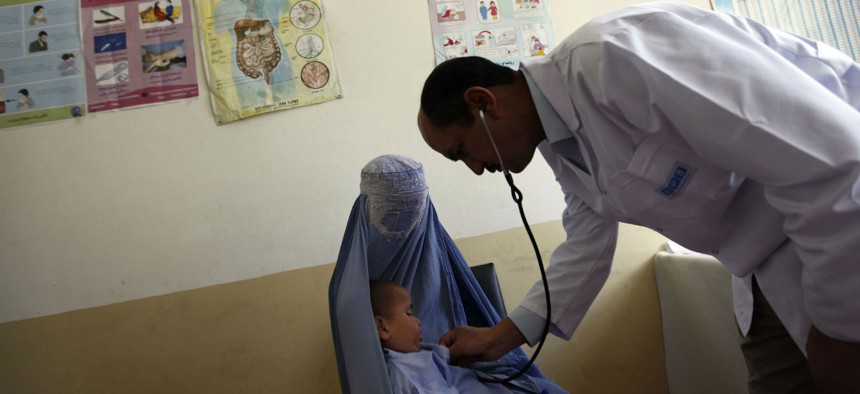
A doctor examines a child at a health clinic in Kabul, Afghanistan. AP file photo
U.S. Aid Agency Can’t Accurately Locate Health Clinics in Afghanistan, IG Says
Better photos could expose safety and security flaws, watchdog says.
In the latest in an ongoing dust-up, the U.S. Agency for International Development is taking a hit for failing to accurately identify the locations of dozens of public health clinics it is helping the government of Afghanistan construct, many of which may be unsafe or unsanitary.
In a Jan. 5 letter released on Monday, the Special Inspector General for Afghanistan Reconstruction said its field auditors since last summer found that as many as seven of 32 clinics in the capital city of Kabul were “more than 5 kilometers away from the coordinates provided by USAID and the Afghan Ministry of Public Health.” Six facilities were more than 10 kilometers from the USAID coordinates.
Five of the facilities visited “did not have running water, three appeared not to have electricity, and eight may not have adequate or consistent power required for proper lighting and to refrigerate some pharmaceuticals and vaccines,” John Sopko said in his letter to USAID Administrator Gayle Smith. “The absence or inconsistency of electricity to refrigerate these basic stocks raises questions about whether the USAID funding is indeed reaching these facilities.”
At least 16 facilities disposed of medical waste in open-air kilns, some of which were publicly accessible, the watchdog wrote. “This method of unsecured disposal does not adhere to best practices and raises the risk that patients seeking treatment—or children we observed playing outside at several facilities—could be accidently exposed to contaminated waste.
“As SIGAR has stressed previously, robust program oversight requires specific knowledge of the location where the service is provided, and accurate location-specific information is critical to ensure that the local population is receiving the intended services,” Sopko said. His team also faulted some of the photos provided by USAID for being unclear on the clinics’ locations in the war-torn country.
SIGAR encouraged USAID to “require its monitoring teams and partners to use cameras that are capable of producing photos with embedded geospatial data and conduct more robust site inspections that include descriptions of facility condition and operations, and take action to ensure that all of the health facilities it supports in Kabul are operating with the utilities necessary to ensure proper patient care and treatment.”
In response to a draft of the letter, acting Mission Director Tamra Halmrast-Sanchez said progress on improving and precisely identifying the locations of clinics is evident. “USAID ensures that adequate oversight occurs for all USAID-supported projects,” she wrote, noting that U.S. teams are working with the Afghan Ministry of Public Health to treat 1 million patients in the clinics every month.
Halmrast-Sanchez said she is “pleased that SIGAR located all 32 USAID-supported clinics they inspected in Kabul, and affirmed their importance to the Afghan communities.” The health ministry had updated clinic coordinates for 14 provinces, she added, and USAID has monitored and identified issues with bathroom cleanliness, access to electricity and site security.
NEXT STORY: What the Latest Obamacare Repeal Is Really About







